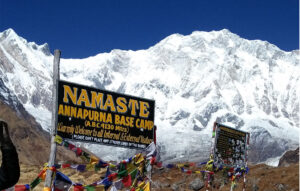
The Annapurna Base Camp (ABC) trek is one of the most popular trekking activities in Nepal. Attracting thousands of trekkers annually, it stands alongside the Everest Base Camp (EBC) trek as a cornerstone of the Nepal trekking industry. However, while EBC is known for its altitude, ABC is celebrated for its diverse attractions, including natural beauty and cultural experiences. In this blog, we’ll explore the intricacies of the Annapurna Base Camp trek distance, offering insights into daily walking expectations, altitude challenges, and preparation tips.
Total Distance of the Annapurna Base Camp Trek
The total distance of the Annapurna Base Camp trek is approximately 110 kilometers (68 miles). This journey can typically be completed in about 11 to 12 days, though the exact duration can vary based on individual pace and route variations. The trek is designed to be both a cultural and natural odyssey, with each step offering new and breathtaking vistas.
Daily Walking Distance
Trekkers can expect to walk an average of 10 to 11 kilometers (6 to 7 miles) per day. This translates to roughly 6 to 7 hours of walking each day, depending on your pace and physical stamina. The trail is a mix of uphill and downhill segments, which adds to the physical demands of the trek. It’s important to prepare adequately for these challenges to ensure a successful and enjoyable trekking experience.
Maximum Altitude
The highest point on the Annapurna Base Camp trek is 4,130 meters (13,549 feet) at the base camp itself. Reaching this altitude involves significant acclimatization and preparation, but it’s achievable with the right mindset and physical readiness. Altitude sickness is a concern, but proper acclimatization days and a steady pace can mitigate its risks.
Comparisons with Other Trekking Routes
While the Annapurna Base Camp trek covers a shorter distance than the Everest Base Camp trek (110 km vs. 130 km), it is not necessarily easier. The ABC trek involves numerous ascents and descents, testing physical stamina and perseverance. In contrast, the EBC trek involves a gradual ascent to a higher maximum altitude (5,545 meters or 18,192 feet). Both treks offer unique challenges and rewards, making each a distinct adventure.
Preparation for the Trek
Physical Training: Begin a regimen of cardiovascular exercises like running, cycling, and swimming at least a month before the trek. Focus on building endurance and leg strength.
Practice Hiking: Engage in regular hikes, especially on trails with significant elevation changes. This will help your body adapt to the demands of the trek.
Gear Up: Invest in high-quality trekking gear, including sturdy boots, a comfortable backpack, warm clothing, and a reliable sleeping bag. Trekking poles and a first aid kit are also essential.
Acclimatization: Plan for acclimatization days within your itinerary to help your body adjust to the altitude. Stay hydrated, eat well, and ascend gradually to reduce the risk of altitude sickness.
Best Time to Trek
The best time to undertake the Annapurna Base Camp trek is during the spring (March to May) and autumn (September to November) seasons. These periods offer the most stable weather conditions and the clearest mountain views. During spring, trekkers can enjoy blooming rhododendrons and lush vegetation, while autumn provides crisp air and vibrant cultural festivals like Dashain and Tihar.
Cultural and Natural Attractions
The Annapurna region is renowned for its cultural richness and natural beauty. Trekkers pass through traditional Gurung and Magar villages, experiencing local hospitality and customs. The trail offers diverse landscapes, from terraced fields and dense forests to alpine meadows and towering peaks. Key highlights include:
Machapuchare Base Camp: A stunning stop offering panoramic views of the Annapurna range.
Ghorepani Poon Hill: A popular detour for sunrise views over the Himalayas.
Hot Springs at Jhinu Danda: A perfect spot for relaxation and rejuvenation after days of trekking.
Shortening the Trek
For those with limited time, it’s possible to shorten the Annapurna Base Camp trek by excluding certain segments, such as the Poon Hill route. Shorter versions of the trek can be completed in 6 to 7 days, focusing on the core sections leading directly to the base camp. Custom itineraries can be crafted to suit individual schedules and preferences.
Tips for a Successful Trek
Hydration and Nutrition: Staying hydrated is crucial, especially at higher altitudes. Drink plenty of water and include electrolytes in your diet. Eating a balanced diet rich in carbohydrates, proteins, and fats will keep your energy levels up.
Rest and Recovery: Ensure you get adequate rest each night. Take breaks during the trek to avoid overexertion and give your muscles time to recover.
Mental Preparation: Mental fortitude is as important as physical fitness. Stay positive, focus on the breathtaking surroundings, and enjoy the journey.
Trekking Routes: Your Partner in Adventure
Choosing a reliable trekking company can make a significant difference in your trekking experience. At Trekking Routes, we offer comprehensive trekking packages tailored to your needs. With over two decades of experience, our team provides expert guidance, ensuring your safety and enjoyment throughout the trek.
Why Choose Trekking Routes as your Trek Partner?
- Experienced Guides: Our guides are seasoned professionals with extensive knowledge of the Annapurna region. They provide valuable insights into the local culture and geography, ensuring a rich and informative trekking experience.
- Customized Itineraries: We offer flexible itineraries that can be customized to fit your schedule and preferences. Whether you want a short trek or a comprehensive journey, we’ve got you covered.
- Safety and Comfort: Your safety is our top priority. We provide high-quality equipment, maintain rigorous safety standards, and offer medical support throughout the trek.
- Cultural Immersion: Experience the rich culture of the Annapurna region with our cultural tours. Interact with local communities, participate in traditional activities, and gain a deeper understanding of the region’s heritage.
- Sustainable Tourism: We are committed to responsible and sustainable tourism. Our practices aim to minimize environmental impact and support local communities.
The Annapurna Base Camp trek distance of 110 kilometers offers an exhilarating blend of natural splendor and cultural depth. Covering this distance requires physical preparedness and a sense of adventure, but the rewards are unparalleled. From lush forests and terraced fields to the awe-inspiring Annapurna Sanctuary, every step of this trek is a testament to Nepal’s breathtaking beauty and rich heritage. Whether you’re a seasoned trekker or a novice, the ABC trek promises an unforgettable journey, making it a jewel in the crown of Nepal’s trekking destinations.
For more details on preparing for the Annapurna Base Camp trek or to customize your trekking itinerary, visit our website or contact our travel planners. Embark on this adventure with confidence and create memories that will last a lifetime with Trekking Routes.







0 Comments